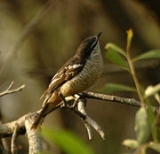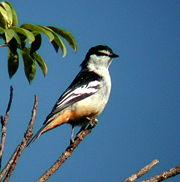
Varied Triller
Encyclopedia

White-winged Triller
The White-winged Triller is one of the smaller members of the Cuckoo-shrike family, Campephagidae. It is found throughout mainland Australia and possibly on the islands to the north, including New Guinea and eastern Indonesia...
, is a smaller member of the Cuckoo-shrike
Cuckoo-shrike
The cuckooshrikes and allies in the Campephagidae family are small to medium-sized passerine bird species found in the subtropical and tropical Africa, Asia and Australasia...
family, Campephagidae. Varied Trillers prefer warm, reasonably moist environments and are found in New Guinea
New Guinea
New Guinea is the world's second largest island, after Greenland, covering a land area of 786,000 km2. Located in the southwest Pacific Ocean, it lies geographically to the east of the Malay Archipelago, with which it is sometimes included as part of a greater Indo-Australian Archipelago...
and the Bismarck Archipelago
Bismarck Archipelago
The Bismarck Archipelago is a group of islands off the northeastern coast of New Guinea in the western Pacific Ocean and is part of the Islands Region of Papua New Guinea.-History:...
, along much of the tropical and sub-tropical coastal hinterland of eastern Australia
Australia
Australia , officially the Commonwealth of Australia, is a country in the Southern Hemisphere comprising the mainland of the Australian continent, the island of Tasmania, and numerous smaller islands in the Indian and Pacific Oceans. It is the world's sixth-largest country by total area...
, from about the Sydney
Sydney
Sydney is the most populous city in Australia and the state capital of New South Wales. Sydney is located on Australia's south-east coast of the Tasman Sea. As of June 2010, the greater metropolitan area had an approximate population of 4.6 million people...
area to the tip of Cape York Peninsula
Cape York Peninsula
Cape York Peninsula is a large remote peninsula located in Far North Queensland at the tip of the state of Queensland, Australia, the largest unspoilt wilderness in northern Australia and one of the last remaining wilderness areas on Earth...
, in the moister part of the Kimberley
Kimberley region of Western Australia
The Kimberley is one of the nine regions of Western Australia. It is located in the northern part of Western Australia, bordered on the west by the Indian Ocean, on the north by the Timor Sea, on the south by the Great Sandy and Tanami Deserts, and on the east by the Northern Territory.The region...
, and throughout the Top End
Top End
The Top End of northern Australia is the second northernmost point on the continent. It covers a rather vaguely-defined area of perhaps 400,000 square kilometres behind the northern coast from the Northern Territory capital of Darwin across to Arnhem Land with the Indian Ocean on the west, the...
.
Common to very common in the north, they are uncommon to rare in the colder south. Typical habitat is rainforest, vine forest, riverine thickets, eucalypt forest and woodland, with a particular preference for the border areas between closed and open forests.
Varied Trillers work their way slowly and methodically through foliage at any level (sometimes on the ground), searching in pairs or small groups for insects and fruit, and making repeated rolling contact calls almost continuously.

